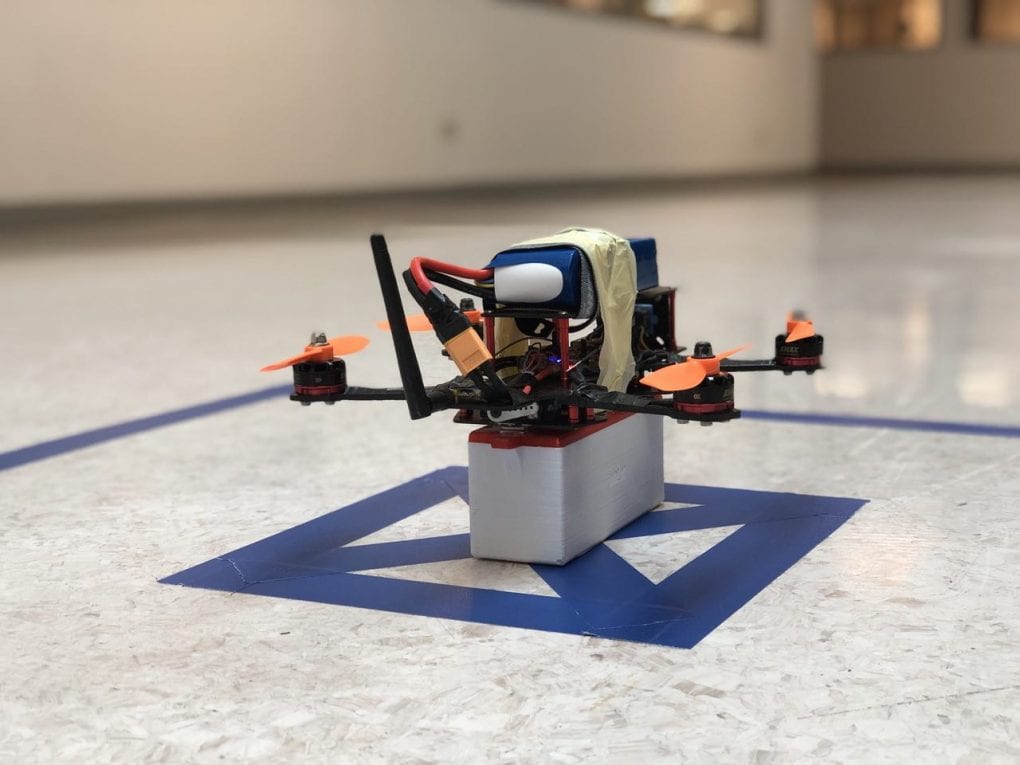Initial Design

Our initial prototype was built with a 360mm carbon fiber X-quadcopter frame with landing gear. The specifications were as follows:
- Motors: 4 x EMAX RS2205 2300kv motors
- Propellers: 4 x 6045 plastic propellers
- ESC: 4 x 40A ESCs
- Battery: 4S 60C 3300mAh lithium-polymer (LiPo) battery
- Flight controller: Pixhawk mini
The package was to be attached and released using electromagnets.
Prototype 1

Our first prototype, nicknamed TRENT, used the 360mm carbon-fiber X-shaped quad frame, which was bought as part of a kit. Because the kit included all the components we need to build a quadcopter, we decided to build the drone using the parts included in the kit (especially since we were still waiting for the rest of our parts to arrive).
The parts we used are as follows:
- 4 x JMT 920kv motors
- 4 x 8045 carbon fiber propellers
- 4 x 30A ESCs
- 3S 45C 3300mAh LiPo battery
- Flight controller: Radiolink Mini Pix
Problems with TRENT
- The structural integrity of the carbon fiber frame was questionable.
- The Radiolink Mini Pix proved difficult and near-impossible to calibrate, resulting in a highly unstable flight.
- The quadcopter was too large.
- The carbon fiber propellers were a safety risk.
- The battery, motors and propellers did not provide enough thrust needed to lift a payload in addition to the unladen weight of the drone.
- There was no camera on board to provide a first-person view, which is needed for manual flying out of the line of sight of the pilot.
Improvements made
- Ordered a new frame that was smaller (250mm) and made from a stronger carbon fiber
- Ordered a new flight controller (F4 flight controller with Betaflight)
- Ordered plastic propellers (5045 plastic propeller) to fit the new smaller frame
- Replaced parts with originally-ordered parts, which had just arrived
- Mounted a FPV camera onto the new prototype
Eventually, TRENT was scrapped for spare parts.
Prototype 2

This prototype, nicknamed CHARM, was built on a 250mm H-shaped quadcopter frame. These made use of the parts we had originally ordered, which are:
- 250mm carbon fiber H-shaped quadcopter frame
- 4 x EMAX RS2205 2300kv motors
- 4 x 5045 plastic propellers
- 4-in-1 ESC with built-in power distribution & F4 flight controller
- 4S 3300mAh 65C LiPo battery
We managed to order a 4-in-1 ESC with a built-in power distribution and a built-in F4 flight controller, which significantly reduced the weight of the drone. We also mounted an FPV camera on the drone and tested its load-bearing capabilities by attaching up to 550g of steel bars to the bottom of the drone.
Problems with CHARM
- No autonomous piloting/navigation capabilities
- Did not have load-release mechanism to release the payload
Prototype 3

Due to the lack of autonomous piloting and navigation capability on CHARM (limited by the F4 flight controller’s capabilities), we upgraded to a HKPilot Pixhawk and built a new prototype, nicknamed CHARM2. This is because Pixhawk firmware is capable of providing autonomous piloting and navigation for the drone.
Other than the new flight controller, we also mounted some servos and attached the load to the drone using neodymium magnets.

As the servos rotate, the servo horns hit the spacer and exert a shear force, thus releasing the payload as the magnets detach from each other due to the shear force.
The payload container was 3D-printed in the lab to fit the drone’s base plate nicely as well as to include the spacers at the end of the box (refer to the picture).
Problems with CHARM2
After many painful days of calibration, we decided to take CHARM2 out to the field for some test flights. The prototype flew well on manual control, but unfortunately, it crashed and became unsalvageable during a test of its autonomous flight programs.
Thus, we decided to revert to the old F4 flight controller used on CHARM and fly the drone manually only.
Final Product

Our final product, also nicknamed CHARM CUBE, was a combination of Prototypes 2 and 3. We took off the bottom plate with the servos and magnets from Prototype 3 and mounted that onto Prototype 2. This drone has the capability of delivering about 600 grams of weight at high speeds for about 10 minutes. Unfortunately, it is still fully pilot-controlled.